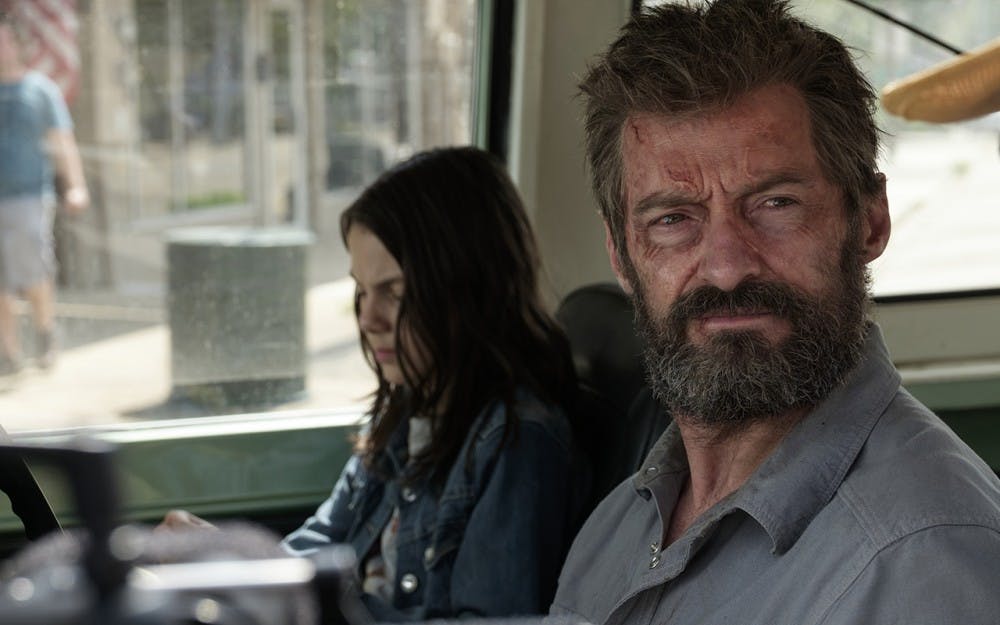Near the end of “Logan,” the stunning, lyrical new entry in the “X-Men” film franchise, there’s a discussion of nightmares. The titular character, better known as Wolverine, tells his young ward she’ll have to get used to bad dreams of her own. She has them too, she tells him, but she only kills bad people. Logan knows better, that bad doesn’t make it easier in the long run.
“Logan” finds its heroes in pretty rough shape to begin with. In its near-future setting, not overtly apocalyptic but rather a deteriorating version of a recognizable America, no mutants have supposedly been born in decades. Logan — played for the ninth and, supposedly, final time by Hugh Jackman — is skin-cracked and grizzled, saddled by guilt and a nagging limp.
He works as a limo driver, ferrying “USA, USA”-chanting party bros around near the United States-Mexico border, and lives south of the border with light-sensitive mutant Caliban (Stephen Merchant). There, they care for professor Charles Xavier (Patrick Stewart), who is beset by some all-too-human degenerative brain disease that manifests in seizures and shockwaves that wreak havoc on the people near him.
Logan is sick, too. He’s been poisoned from the inside by his adamantium skeleton and is carrying around an adamantium bullet for when things get to be too much to bear. He and Charles look to buy a boat and drift off to sea, a plan upended when they find themselves on the run from evildoers with a young mutant named Laura (newcomer Dafne Keen), who has claws a lot like Logan’s.
The narrative structure of “Logan” is pleasantly linear, and by doing away with the backstory and convoluted intrigue that can plague blockbusters like these, the film has plenty of space for character development and theme building.
“Logan” has a lot of thematic weight to cart around, and director James Mangold’s deft touch in presenting it is perhaps the film’s greatest success. It’s fundamentally a film about confronting mortality, but it also has a lot to say about fathers, sons and daughters, and its plot — concerning children fleeing a bad life south of the border, but heading for Canada because the U.S. isn’t safe for them — is hard to read as anything other than an immigration metaphor.
It could’ve been easy for Mangold to beat viewers over the head here, but “Logan” is wonderfully understated. That’s not to say it’s minimalist — with an R rating attached, viewers finally get to see what Wolverine’s claws can really do — but it treats violence with gravity, levity with elation and emotional moments with a sugar-free approach that elevates them to immense beauty.
The most ceaseless debate among fans and critics in the world of post-“Dark Knight” superhero cinema has been the viability of the “dark-and-gritty” superhero movie. “Logan” fits that bill in a literal sense, given its themes and stark violence.
It’s also like nothing else the genre has produced. The touchstones here are less Christopher Nolan and Zack Snyder than they are Cormac McCarthy, Clint Eastwood and Johnny Cash. Mangold — who also helmed 2013’s “The Wolverine,” the Cash biopic “Walk the Line” and the 2007 remake of “3:10 to Yuma” — isn’t similar in style to Bryan Singer, who’s directed several of the franchise’s films, so much as he is Jeff Nichols or even the Coen brothers in their Western mode.
All of this opens the floor for superb performances from the core cast. Keen’s range is impressive: Laura starts the film as a mute, feral child, and while the young actress brings an essential energy to that aspect of the character, she exudes a preternatural maturity as the film goes. Stewart is given two of the best moments in the film’s first half, including a crushing monologue at the point where “Logan” goes from good to great.
And Jackman finally gets the most out of the character that’s defined his career. Wolverine has always been a lonely, curmudgeonly asshole, but here, Jackman teases out every thread and demon that comprises the character’s being.
“Logan” doesn’t just work because it’s barely a superhero movie or because its main reference points are other genres and “serious” art. It works because of the care and humanity packed into it, and because it treats character and theme, rather than fan service, showy set-pieces or all-star casts, as its heart.
As for those nightmares: “Logan” is a fairly bleak film, at least as far as releases of its magnitude go. But what makes it so shockingly gorgeous is the hope sprinkled throughout — in an old western on a hotel room television, in a family dinner shared with decent people and, especially, in its quietly devastating ending. It’s a film about fierce love and redemption, about how we can transcend the things we’ve done and the people we perceive ourselves to be — about how, at our best, we can be truly good.




